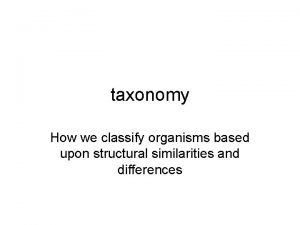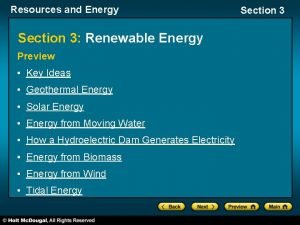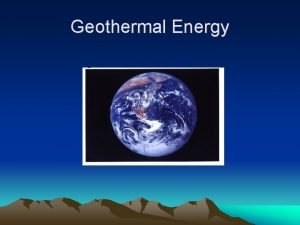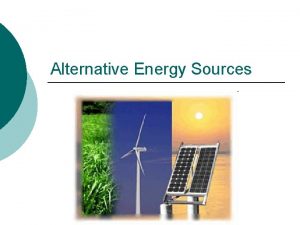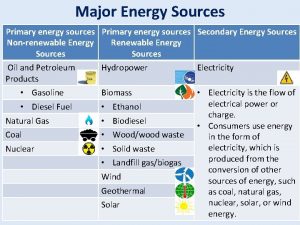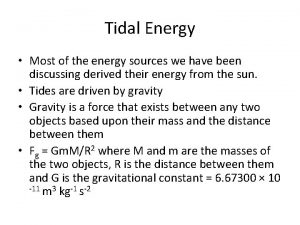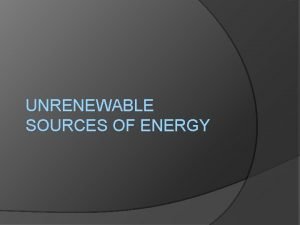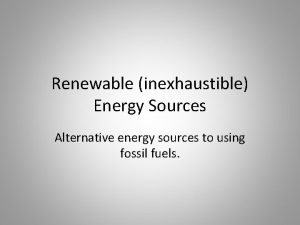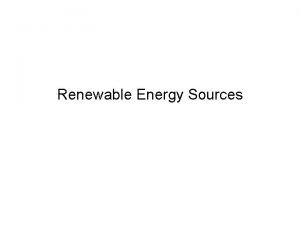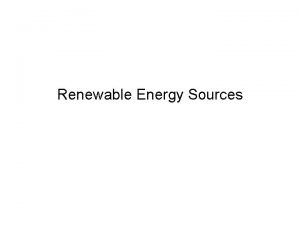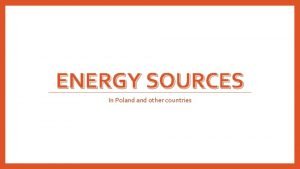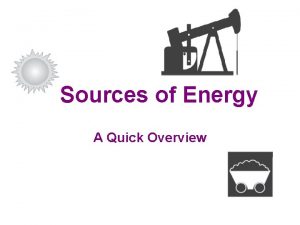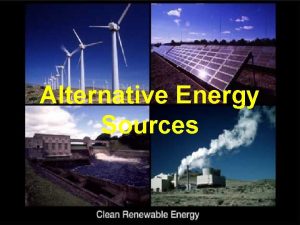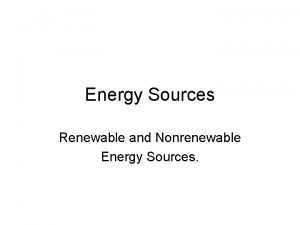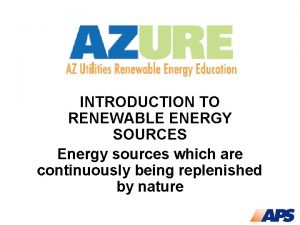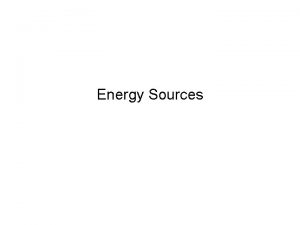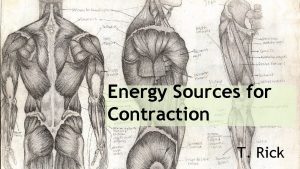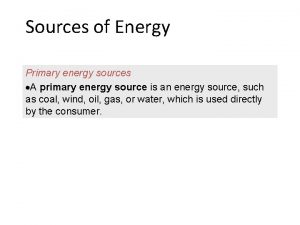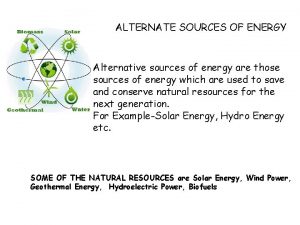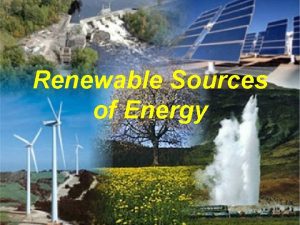Chapter 9 SOURCES OF ENERGY Energy Sources Most


























- Slides: 26

Chapter 9 SOURCES OF ENERGY

Energy Sources • Most energy generated today comes from burning fossil fuels • These are “non-renewable” energy sources • Coal will run out in approx. 300 years • Oil will run out in approx. 40 -70 years • Natural gas will run out in approx. 70 -110 years

Renewable Energy Sources • • • Biomass Solar Wind Geothermal Tidal

Resources and Reserves • Resource- potentially extracted- not economic to extract at present time • Reserve- known deposits that can be extracted with current technology, under present economic conditions and be profitable

Coal Formation • Organic matter dies and is covered by water (peat) • Then covered by sediment (lignite) • Increased pressure and temperature get bituminous coal • Increase pressure and temperature some more and result is anthracite coal

Composition of Coal Types PEAT LIGNITE BITUMINOUS ANTHRACITE WATER 90% 43% 3% 3% VOLATILES 5% 19% 32% 1% FIXED CARBON 5% 38% 65% 96%

Coal • Most abundant fossil fuel • Supplies about 42% of United States electricity 3 Types: Lignite Bituminous- most abundant, easiest to obtain Anthracite- deeper, cleaner burning

Ways of Obtaining Coal 1. Strip Mining- becoming much more common in last 40 years (done when seam is not too deep) Problems: Disrupt landscape Must reclaim land Takes long time for area to return to original productivity

Ways of Obtaining Coal 2. Underground Mining Less impact to surface environment Subsidence (sinking) can occur Large waste heaps (bony piles)

Health and Pollution Issues • Mining is Dangerous – Black Lung Disease – Mine Accidents (Quecreek, Chile)

Health and Pollution Issues • Dust pollution • AMD- occurs when sulfur in coal reacts with water • Oxygen + Water + Sulfur forms Sulfuric acid, polluting streams and making them uninhabitable • Burning coal plays a role in acid rain, air pollution, and global warming

Oil • • Extraction causes less env. damage than coal Burns cleaner than coal Accounts for only about 1% of U. S. electricity Can be transported through pipelines More expensive to locate and retrieve Most oil in world is found in the Middle East Off-shore drilling more common ($, accidents)

Processing Oil 1. Separate components by heating 2. Then “crack” by adding heat and pressure to separate further -Result is gasoline, kerosene, petrochemicals -Petrochemicals are used for making plastics and other synthetic compounds -Oil spills are only 1/3 of pollution in ocean -Oil spills on land can pollute groundwater, soil, etc

Natural Gas • Supplies about 25% of U. S. electricity • Freezing (-162 C) liquefies gas and can be transported in tanker trucks where pipelines don’t exist • Least disruptive environmentally of all fossil fuels • Cleanest burning of fossil fuels • Becoming more popular in U. S. , especially PA and NY (Marcellus Shale)

Electricity Production in U. S. Source Percentage Coal 42 Natural Gas 25 Oil 1 Nuclear 19 Hydroelectric 8 Wind 3 Biomass 1 Solar 1

Renewable Energy Sources 1. Hydroelectric • In early 1900 s, 50% of U. S. electricity came from hydroelectric power • Early uses included milling grain, sawing lumber, running machines in textile factories • Today, primarily used for electricity generation

Problems with Hydroelectric Power • Most suitable dam sites are already used • Severely alters aquatic ecosystems • Prevents sediment from flowing downstream to flat, fertile farmlands to replenish the soil • Barrier for migrating fish (salmon, shad) now building “fish ladders” around dams

3 Gorges Dam in China • Largest hydropower project in world • Wall is 610 feet tall and 1. 3 miles from bank to bank across Yangtze River • Displaced 1. 2 million people • Flooded 13 cities, 140 towns, 1, 350 villages • Approximately 373 miles long (about width of PA) • Submerged factories, mines, dumps, etc.

Tidal Energy • Tides caused by gravitational pull of sun and moon along with rotation of Earth • Finding suitable sites is challenging • Tides are strongest near poles and in bays or estuaries that are narrower to magnify the impact of the tides

Geothermal Energy • Steam contains H 2 S (hydrogen sulfide)produces slight odor • Minerals in steam can corrode pipes = maintenance problems • Minerals are toxic to fish • Most efficient sites are around volcanoes and active fault lines

Wind Power • Steady source of wind necessary • Harmful to birds and bats, some of which are endangered • Some noise pollution • Major complaint is aesthetics

Solar Energy • Amount of solar energy that reaches Earth each day is 600 X the amount produced by all other sources • Main problem is intermittent nature • Not suitable for older homes and colder climates • Collectors and photovoltaic cells are still expensive compared to traditional methods

Biomass Conversion • Food shortages because of using crops for biomass drives food prices up in U. S. • Alcohol produced from conversion of corn is less than energy required to grow corn

Fuelwood • Primary source of energy for half of world’s population (cooking) • Population growth in these areas has caused wood to be harvested faster than it can regenerate = desertification • When burning wood, 75 organic compounds are released, of these 22 are known or suspected carcinogens

Solid Waste • Only about 3 -5% of burnable waste is utilized in the U. S. • Air pollution and carcinogens released are some problems • Also, recycling becoming more popularplastics are being recycled (have a high heat content)

Conservation • 3 R’s: Reduce, Reuse, Recycle • Energy efficient appliances, windows, lights • Think about future before making decisions/purchases
 Print and web sources
Print and web sources Water resources important
Water resources important In an energy pyramid where is the most energy
In an energy pyramid where is the most energy Energy energy transfer and general energy analysis
Energy energy transfer and general energy analysis Energy energy transfer and general energy analysis
Energy energy transfer and general energy analysis Most general to most specific classification
Most general to most specific classification Most general to most specific classification
Most general to most specific classification Almighty allah the most merciful
Almighty allah the most merciful The most
The most سsh
سsh Guddi baji
Guddi baji Organisms taxonomy
Organisms taxonomy Arrangement of organisms
Arrangement of organisms In the name of god, most gracious, most merciful prayer
In the name of god, most gracious, most merciful prayer In the name of allah, the most gracious, the most merciful
In the name of allah, the most gracious, the most merciful In the name of allah the most
In the name of allah the most The most gracious
The most gracious Aqeedah in islam
Aqeedah in islam In the name of god the most gracious the most merciful
In the name of god the most gracious the most merciful In the name of allah the most beneficent the most merciful
In the name of allah the most beneficent the most merciful Section 3 renewable energy sources worksheet answers
Section 3 renewable energy sources worksheet answers Concept clean energy
Concept clean energy Nonrenewable energy sources
Nonrenewable energy sources Energy transformation
Energy transformation Nonrenewable energy sources
Nonrenewable energy sources Natural sources of heat
Natural sources of heat Sources of geothermal energy
Sources of geothermal energy





